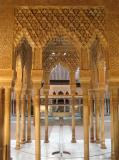Posted under France

The French Riviera, the Cote d’Azur, the south of France…vacation destination for jet set Europeans, playground for the rich and famous, where celebrities are photographed frolicking on the beautiful beaches only to have their bodily imperfections magnified in gossip magazines. We had set our sights on Nice, the second most-visited French city (after Paris), planning to steal a glimpse of St. Tropez, Cannes, and other famous cities along the coastal road. The sapphire waters of the Mediterranean invigorated and enchanted us as we endured the traffic and inadequate signage through the pretty seaside towns.
We were delighted to discover that our hotel in Nice was only two blocks from the beach, though parking proved to be a challenge. It had been a long day of driving so, despite our eagerness to explore, we settled in and relaxed for the evening.
The next morning, we set out early to spend the day in Monaco. Measuring a mere 1.95 square kilometers, Monaco is the world’s second smallest country – only the Vatican is smaller. The entire country curves around the glistening, yacht-filled Port de Monaco. We parked just north of the port in the capital city of Monte Carlo and began our walk. The famous Casino Monte Carlo was thronged with photo-snapping tourists who rudely left handprints (and probably saliva) all over the Ferraris and Lamborghinis parked in front. The decadence of the cars, clothes, and jewels on display in Monaco were unparalleled by anything we have seen. The architecture dripped with sculptures, murals, and beautiful wrought iron detail. The yachts in the port were a vision of eye-popping flash seen only in rap videos.
We made our way toward the port and sat down at a waterside café for lunch to drool over the boats for an hour before continuing to the Prince’s Palace. The ascent to the palace was laborious but afforded the best views of Monaco. The palace exterior was less remarkable than I’d expected, considering the artistry in Monaco’s other grand facades. We browsed the souvenir shops and had just turned down a shaded alley of shops when the sound of church bells echoed through the stone corridor. We followed the sound of the bells through a maze of stone and stumbled upon the Cathedral de Monaco, a beautiful church overlooking the sea. A crowd of tourists were gathered across the circle and we scurried over to see what was going on. A wedding! On the church steps were gathered Monaco’s elite, dressed to impress for the gorgeous affair. The bride and groom soon appeared through a shower of flower petals, followed by pretty blond bridesmaids in canary yellow gowns. We watched the merriment for a few minutes and then headed back down towards the port. The wedding was an unexpected and marvelous surprise.
Monaco was a spectacle of wealth and glamour. The ladies of Sex and the City would definitely have approved.

Back in Nice, we divided our remaining time equally between Vieux Nice (the old town) and the beach. The old town was full of life, especially at night when the restaurants were abuzz and musicians filled the lanes with sounds from around the world. Gelato stands were ubiquitous. Outdoor cafés filled the lanes with Heavenly aromas and wine-induced chatter.
The beaches in Nice were polished gray pebbles, which were less comfortable than sand, but the cool blue ocean was intensely refreshing. A day rental of a beach chair and parasol in Nice runs about 20 euro per person so we joined the hordes of locals in setting up camp on the pebbles. The tanned, toned bodies on the beach added to the beauty of the already spectacular seascape. Above the beach, the promenade des Anglais (English promenade) was a wide, palm-lined boardwalk with plenty of beachfront seating, snack vendors and rollerblading locals. It was a wonderful place for a stroll both day and night.
 The Cote d’Azur was the perfect conclusion to our adventures in France. There is nothing like a sparkling beach to make you feel like you’re on vacation. Nice seemed like a relaxed and livable city, perhaps more so outside of tourist season. The cafés were surprisingly unpretentious; the food and wine were wonderful; and the streets were picturesque and full of life. It has been our pleasure to share our adventures in France with Aaron’s mother and we hope that her memories of the experience are as fond as ours.
The Cote d’Azur was the perfect conclusion to our adventures in France. There is nothing like a sparkling beach to make you feel like you’re on vacation. Nice seemed like a relaxed and livable city, perhaps more so outside of tourist season. The cafés were surprisingly unpretentious; the food and wine were wonderful; and the streets were picturesque and full of life. It has been our pleasure to share our adventures in France with Aaron’s mother and we hope that her memories of the experience are as fond as ours.
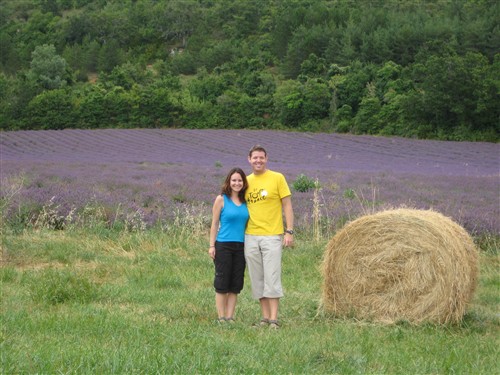
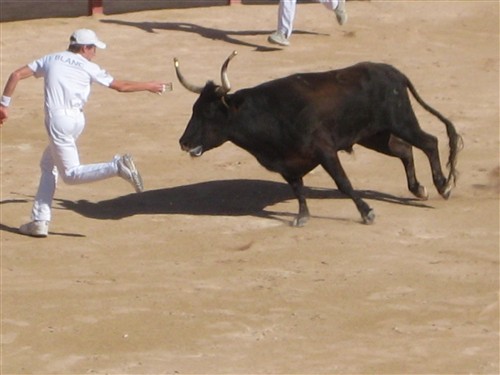 Built in the 1st and 2nd centuries, Arles’ Roman amphitheatre still serves as the venue for bullfighting and bull races. What is a bull race? Snarling, snorting trained bulls are pinned with special ribbons around their horns. A bull is released into the arena. Young, nimble men, dressed all in white, attempt to snatch the bull’s ribbons with tiny dull hooks. There are upwards of fifteen men playing simultaneously against a single bull and still the bull usually wins, inciting roars of applause from the fedora-clad spectators. The most exciting moments of the event are when the bull leaps over the arena wall and goes running around the perimeter until it is lured back inside. The crowd loves this. Each bull lasts about twenty minutes, daring the challengers to get close to its ferocious horns, and then the next bull enters in a rage of fury. Each bull has a unique fiery personality. Best of all, the bull is not killed at the end as it is in a bullfight. The bull lives to snarl another day!
Built in the 1st and 2nd centuries, Arles’ Roman amphitheatre still serves as the venue for bullfighting and bull races. What is a bull race? Snarling, snorting trained bulls are pinned with special ribbons around their horns. A bull is released into the arena. Young, nimble men, dressed all in white, attempt to snatch the bull’s ribbons with tiny dull hooks. There are upwards of fifteen men playing simultaneously against a single bull and still the bull usually wins, inciting roars of applause from the fedora-clad spectators. The most exciting moments of the event are when the bull leaps over the arena wall and goes running around the perimeter until it is lured back inside. The crowd loves this. Each bull lasts about twenty minutes, daring the challengers to get close to its ferocious horns, and then the next bull enters in a rage of fury. Each bull has a unique fiery personality. Best of all, the bull is not killed at the end as it is in a bullfight. The bull lives to snarl another day!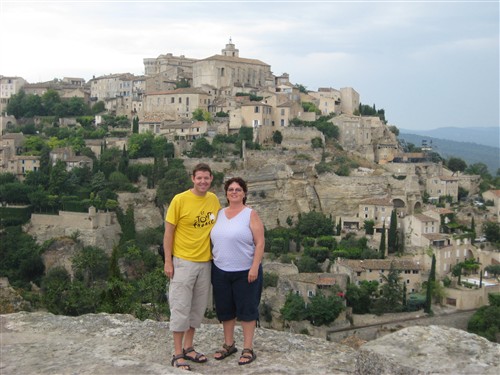 The most fruitful element of our Avignon stop was a visit to the tourist office where a woman explained in wonderful English where we could find the lavender. With renewed enthusiasm, we hopped back into the car and headed northeast toward Sault. It wasn’t long before we squealed with delight at our first glimpse of lavender fields near the golden city of Gordes, which was itself a hidden gem. Built entirely of stone and spilling down a steep mountainside, the picturesque cityscape was a stunning sight, bathed in the golden light of the late afternoon sun. Around Gordes, we discovered sweeping mountain valleys with plots of lavender and grapevines interwoven like a patchwork quilt. The car provided us unlimited freedom to span the countryside and, between Gordes and Sault, we found more and more lavender. We drove all day, arriving back in Arles weary and satisfied with the day’s adventures. Provence, with its charming towns, artistic history, and fields of lavender, exceeded our highest expectations.
The most fruitful element of our Avignon stop was a visit to the tourist office where a woman explained in wonderful English where we could find the lavender. With renewed enthusiasm, we hopped back into the car and headed northeast toward Sault. It wasn’t long before we squealed with delight at our first glimpse of lavender fields near the golden city of Gordes, which was itself a hidden gem. Built entirely of stone and spilling down a steep mountainside, the picturesque cityscape was a stunning sight, bathed in the golden light of the late afternoon sun. Around Gordes, we discovered sweeping mountain valleys with plots of lavender and grapevines interwoven like a patchwork quilt. The car provided us unlimited freedom to span the countryside and, between Gordes and Sault, we found more and more lavender. We drove all day, arriving back in Arles weary and satisfied with the day’s adventures. Provence, with its charming towns, artistic history, and fields of lavender, exceeded our highest expectations.
 As it turned out, our two tasting appointments were wonderful and we left them both smiling and happy. We decided to take a drive along a well-known “chateau trail” as outlined on our map from the tourist office. The Bordeaux region boasts upwards of 5,000 wine-cultivating chateaux. We drove along, stopping at leisure to photograph the lovely facades, including the much-admired Chateau Margaux.
As it turned out, our two tasting appointments were wonderful and we left them both smiling and happy. We decided to take a drive along a well-known “chateau trail” as outlined on our map from the tourist office. The Bordeaux region boasts upwards of 5,000 wine-cultivating chateaux. We drove along, stopping at leisure to photograph the lovely facades, including the much-admired Chateau Margaux. Our road trip continued south toward Bordeaux where bright yellow fields of sunflowers were soon interspersed with sprawling vineyards. On the way, Aaron found the picture-perfect patch of sunflowers so we got out of the car and leaped a narrow ravine (at which time I was reminded that I wasn’t ready to be leaping ravines just yet) to capture the moment. On the way back, a chivalrous gent with big cheeks carried me across like a princess. We arrived in Bordeaux in mid-afternoon and Aaron and Valerie ventured out for a walk while I opted for a few solitary hours of recovery time.
Our road trip continued south toward Bordeaux where bright yellow fields of sunflowers were soon interspersed with sprawling vineyards. On the way, Aaron found the picture-perfect patch of sunflowers so we got out of the car and leaped a narrow ravine (at which time I was reminded that I wasn’t ready to be leaping ravines just yet) to capture the moment. On the way back, a chivalrous gent with big cheeks carried me across like a princess. We arrived in Bordeaux in mid-afternoon and Aaron and Valerie ventured out for a walk while I opted for a few solitary hours of recovery time.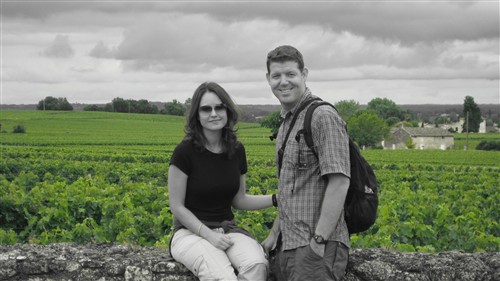
 The town was named after a monk, Emilion, who settled there in the first century, living a hermit’s life in a stone cave for 17 years. Our tour began with a short descent into Emilion’s cave, which consisted of two “rooms” with a bed, a meditation seat, and a small pool from an underground river. Our guide explained that Emilion’s meditation seat is believed to have powers of fertility and that 70-80% of women who sit on the seat send letters attesting to its magic. Guess whose buns were the first ones onto that seat? And once more on the way out…just in case the power didn’t soak in the first time.
The town was named after a monk, Emilion, who settled there in the first century, living a hermit’s life in a stone cave for 17 years. Our tour began with a short descent into Emilion’s cave, which consisted of two “rooms” with a bed, a meditation seat, and a small pool from an underground river. Our guide explained that Emilion’s meditation seat is believed to have powers of fertility and that 70-80% of women who sit on the seat send letters attesting to its magic. Guess whose buns were the first ones onto that seat? And once more on the way out…just in case the power didn’t soak in the first time.
 The highlight of the day (in my biased, dog-loving opinion) was our final stop at Chateau de Cheverny. I had rested in the car between stops so that I would have maximum stamina for our late afternoon visit. The classical façade, pristinely manicured gardens, expansive grounds and magnificent period furnishings were a true pleasure to admire. However, we had come for a different thrill: the soupe des chiens, or feeding of the dogs. “As was the custom among the nobility of centuries past, Marquis Charles-Antoine de Vibraye – whose family has owned Cheverny since it was built – hunts with dogs.” Most of his 100 canines are a cross between English fox hounds and French poitevins. (Lonely Planet France: Jan 07).
The highlight of the day (in my biased, dog-loving opinion) was our final stop at Chateau de Cheverny. I had rested in the car between stops so that I would have maximum stamina for our late afternoon visit. The classical façade, pristinely manicured gardens, expansive grounds and magnificent period furnishings were a true pleasure to admire. However, we had come for a different thrill: the soupe des chiens, or feeding of the dogs. “As was the custom among the nobility of centuries past, Marquis Charles-Antoine de Vibraye – whose family has owned Cheverny since it was built – hunts with dogs.” Most of his 100 canines are a cross between English fox hounds and French poitevins. (Lonely Planet France: Jan 07).